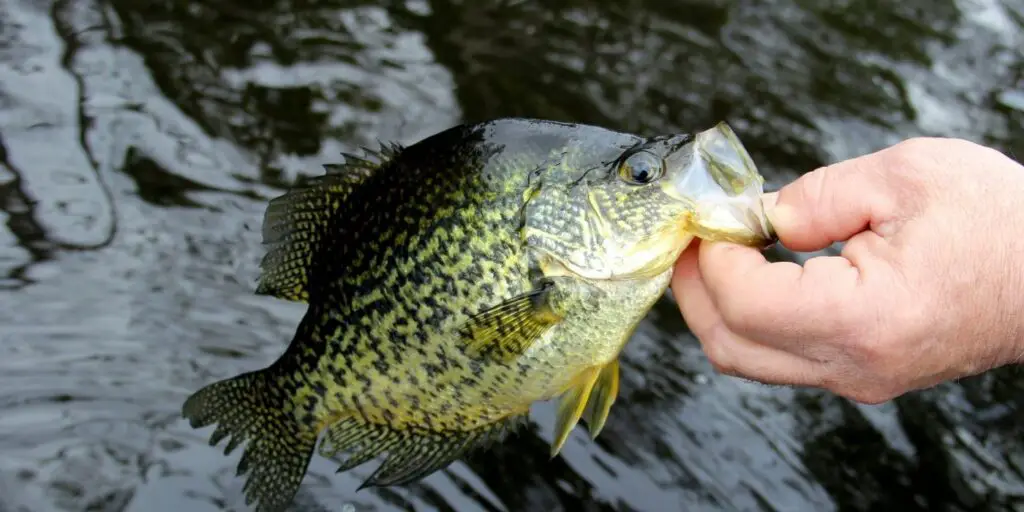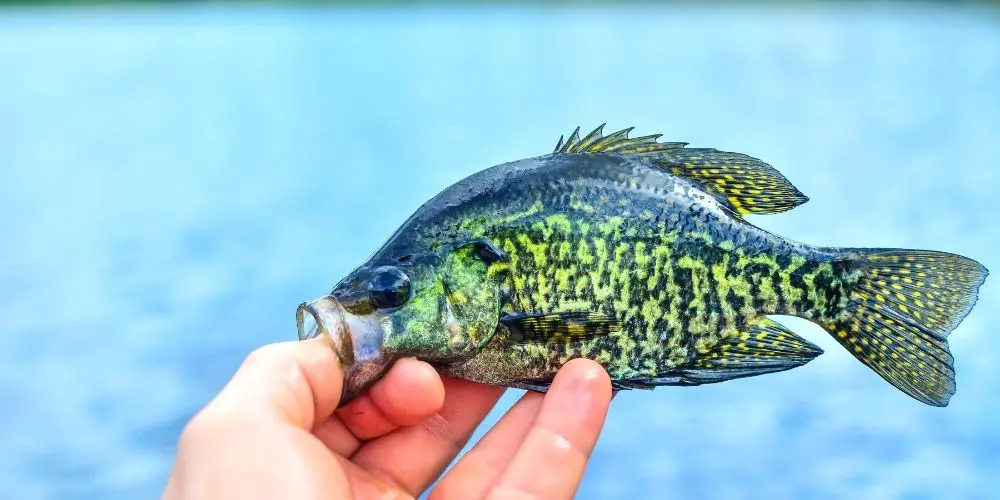Do you ever wonder if crappie bite in the rain? Well, you’re about to find out!
In this article, we will explore the effects of rain on crappie feeding behavior and provide you with tips and techniques for fishing them during rainy weather. By understanding how rain impacts their movements and knowing the best baits and strategies to use, you’ll be well-equipped to catch crappie even when the rain is pouring down.
So, let’s dive in and discover the secrets of catching crappie in the rain!
Key Takeaways
- Rainfall can have both positive and negative impacts on crappie growth and reproduction.
- Crappie tend to seek shelter and become more active during rainy weather, moving to shallower areas and seeking cover.
- The rainwater washes insects and other food sources into the water, attracting crappie to these areas.
- Crappie tend to be less aggressive in rainy conditions, so a slower presentation and using attractants like live minnows or bright-colored jigs can increase chances of catching them.
Is Rain Good for Crappie Fishing?
Yes, rain can be good for crappie fishing. You can have a great day on the water catching crappie during a light shower or following rain.
Overall, while rain can have mixed effects on crappie fishing, many anglers find that light to moderate rain can be beneficial in stimulating crappie activity and improving catch rates.
The Effects of Rain on Crappie Feeding Behavior
The effects of rain on crappie feeding behavior have been a subject of interest among anglers and researchers. Rainfall can have both positive and negative impacts on crappie growth and reproduction.
During light rain showers, crappie tend to remain active and continue feeding. The raindrops create ripples on the water surface, which can attract small prey and make it easier for crappie to locate and catch their food.
However, heavy rainfall and thunderstorms can have a negative effect on crappie feeding. The increased turbidity and reduced visibility caused by heavy rain can make it difficult for crappie to find their prey. Additionally, rapid changes in water temperature and oxygen levels during heavy rain events can temporarily disrupt the feeding patterns of crappie.
Despite these temporary disruptions, crappie are resilient and will resume their normal feeding behavior once the rain subsides.

Tips for Fishing Crappie During Rainy Weather
When it’s raining, it’s best to look for cover near structures or submerged objects. This is because crappie, like many other fish species, tend to seek shelter during rainy weather.
Here are three tips to help you make the most of your fishing experience in the rain:
- Use the right fishing gear: It’s important to have the appropriate equipment when fishing in the rain. Make sure you have a good quality fishing rod and reel that can withstand wet conditions. Additionally, consider using a waterproof tackle box to keep your lures and bait dry.
- Wear proper rain gear: Staying dry is essential for a comfortable and enjoyable fishing trip in the rain. Invest in a good rain jacket and pants that are both waterproof and breathable. Don’t forget a waterproof hat and gloves to protect yourself from the elements.
- Stay patient and observant: Fishing during rain requires a bit of extra patience. The rain can make it more difficult to spot fish, so take your time and pay close attention to any signs of activity in the water. Look for ripples, splashes, or any other disturbances that could indicate the presence of crappie.
Understanding How Rain Impacts Crappie Movements
If you’re fishing for crappie in the rain, understanding how rain impacts their movements is crucial. Rainy weather precautions are essential to maximize your chances of success.
During storms, crappie tend to change their behavior and feeding patterns. They become more active and tend to move to shallower areas, seeking shelter under cover such as fallen trees, docks, or vegetation. The rainwater washes insects and other food sources into the water, attracting crappie to these areas.
Additionally, the rain creates ripples and noise on the surface, which can help camouflage your presence. It’s important to use this to your advantage by casting near these shelters and using lures that mimic the natural prey.
Best Baits and Techniques for Catching Crappie in the Rain
To increase your chances of catching crappie in the rain, try using live minnows or small jigs with bright colors to attract their attention. Crappie are known to be more active and willing to bite during rainy conditions.
Here are the best techniques to catch crappie in the rain:
- Slow presentation: Crappie tend to be less aggressive in rainy conditions, so it’s important to slow down your presentation. Retrieve your bait slowly and give the crappie enough time to strike.
- Fish near cover: During rainy weather, crappie often seek shelter near structures such as fallen trees, brush piles, or submerged vegetation. Focus your fishing efforts near these areas to increase your chances of success.
- Use light tackle: Crappie have a soft mouth, so using light tackle with a sensitive rod and a light line is crucial. This will help you detect subtle bites and ensure a better hookset.
Weather Patterns That Trigger Crappie Activity in Rainy Conditions
You’ll notice that crappie tend to be more active and willing to bite during rainy conditions. Rainy weather fishing can be quite productive when targeting crappie, as they exhibit specific behavior patterns in response to these conditions.
During rainy weather, crappie tend to move closer to the surface and become more active in search of food. The rainwater washes insects and other small organisms into the water, providing an abundant food source for crappie. Additionally, the cloudy and overcast skies associated with rainy conditions create a darker environment, which crappie prefer. They feel more secure and are more likely to venture out and feed.

Strategies for Finding and Targeting Crappie in Rainy Environments
When it’s rainy, one effective strategy for finding and targeting crappie is to focus on areas with abundant food sources washed into the water by the rainwater. Crappie are opportunistic feeders and will often congregate in these areas to take advantage of the easy meal.
Here are three tips to help you make the most of your rainy day crappie fishing:
- Gear and Equipment: Make sure you have the right gear and equipment for fishing in the rain. A waterproof jacket and pants will keep you dry and comfortable, while a hat with a brim and polarized sunglasses will help you see through the rain and spot the crappie. Additionally, using a lightweight fishing rod and reel with a sensitive tip will allow you to detect even the subtlest bites.
- Safety Precautions: Safety should always be a top priority when fishing in rainy conditions. Be aware of your surroundings and avoid fishing near lightning or in areas with strong currents. It’s also a good idea to let someone know where you’ll be fishing and when you expect to return.
- Location: Look for areas with structures such as fallen trees or submerged brush piles. These structures provide cover for crappie and attract smaller baitfish, which in turn attract hungry crappie. Additionally, pay attention to any inflows or areas where rainwater is entering the body of water, as crappie will often gather here to feed on the washed-in food.
Frequently Asked Questions
What Is the Average Lifespan of a Crappie?
The average lifespan of a crappie is around 7 to 10 years. Factors such as water quality, food availability, and fishing pressure can affect their lifespan. Crappie are known for their excellent bite, especially during rainy weather.
How Do Crappie Breed and Reproduce?
Crappie have a fascinating reproductive cycle. They breed in the spring when water temperatures reach 55-65°F. Females lay thousands of eggs, which are then fertilized by males. The eggs hatch in about a week, and the young crappie grow rapidly.
What Are the Different Species of Crappie?
Differentiating between black crappie and white crappie involves examining their physical characteristics, such as coloration and dorsal fin shape. Crappie prefer habitats with submerged vegetation and structure, and their behavior changes depending on environmental factors.
How Deep Do Crappie Typically Swim in the Water?
In the water, crappie typically swim at varying depths depending on their habitat. Understanding crappie feeding behavior is key. Now, let’s explore the effect of rain on crappie biting.
What Are Some Common Predators of Crappie in Rainy Conditions?
Common predators in rainy conditions for crappie include larger fish such as bass and pike. Crappie tend to be more active and feed near the surface during rain, making them vulnerable to predation.
Conclusion
In conclusion, fishing for crappie in the rain can be a successful endeavor if you understand their feeding behavior and make the necessary adjustments.
One interesting statistic to consider is that crappie are known to become more active and aggressive during the first 30 minutes of rainfall, with catch rates increasing by up to 50%.
This image of a sudden burst of activity in the rain can inspire anglers to head out during a light drizzle and capitalize on this unique opportunity to catch more crappie.



